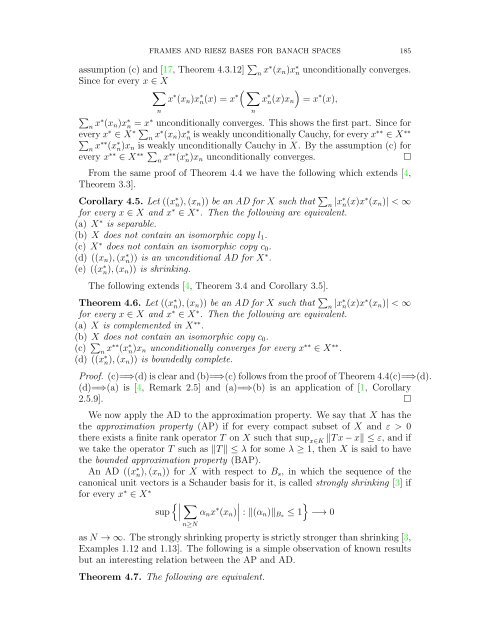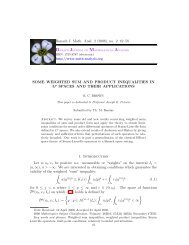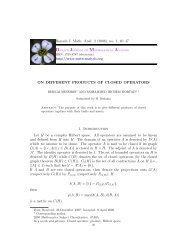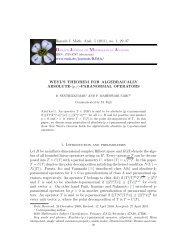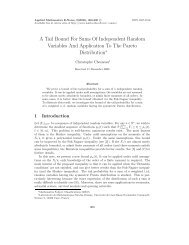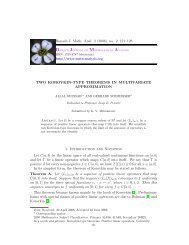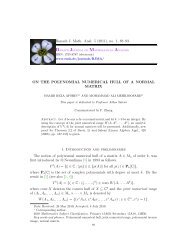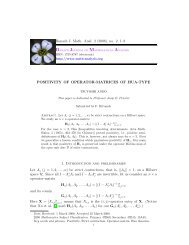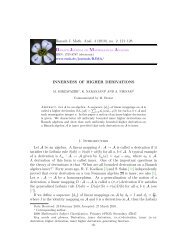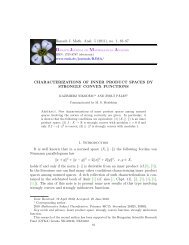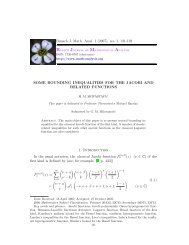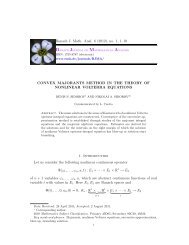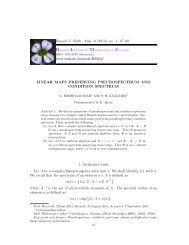Frames and Riesz bases for Banach spaces, and Banach spaces of ...
Frames and Riesz bases for Banach spaces, and Banach spaces of ...
Frames and Riesz bases for Banach spaces, and Banach spaces of ...
- No tags were found...
Create successful ePaper yourself
Turn your PDF publications into a flip-book with our unique Google optimized e-Paper software.
FRAMES AND RIESZ BASES FOR BANACH SPACES 185assumption (c) <strong>and</strong> [17, Theorem 4.3.12] ∑ n x∗ (x n )x ∗ n unconditionally converges.Since <strong>for</strong> every x ∈ X( ∑ )x ∗ (x n )x ∗ n(x) = x ∗ x ∗ n(x)x n = x ∗ (x),∑n∑n x∗ (x n )x ∗ n = x ∗ unconditionally converges. This shows the first part. Since <strong>for</strong>every x ∗ ∈ X ∑ ∑∗ n x∗ (x n )x ∗ n is weakly unconditionally Cauchy, <strong>for</strong> every x ∗∗ ∈ X ∗∗n x∗∗ (x ∗ n)x n is weakly unconditionally Cauchy in X. By the assumption (c) <strong>for</strong>every x ∗∗ ∈ X ∑ ∗∗ n x∗∗ (x ∗ n)x n unconditionally converges.□From the same pro<strong>of</strong> <strong>of</strong> Theorem 4.4 we have the following which extends [4,Theorem 3.3].Corollary 4.5. Let ((x ∗ n), (x n )) be an AD <strong>for</strong> X such that ∑ n |x∗ n(x)x ∗ (x n )| < ∞<strong>for</strong> every x ∈ X <strong>and</strong> x ∗ ∈ X ∗ . Then the following are equivalent.(a) X ∗ is separable.(b) X does not contain an isomorphic copy l 1 .(c) X ∗ does not contain an isomorphic copy c 0 .(d) ((x n ), (x ∗ n)) is an unconditional AD <strong>for</strong> X ∗ .(e) ((x ∗ n), (x n )) is shrinking.The following extends [4, Theorem 3.4 <strong>and</strong> Corollary 3.5].Theorem 4.6. Let ((x ∗ n), (x n )) be an AD <strong>for</strong> X such that ∑ n |x∗ n(x)x ∗ (x n )| < ∞<strong>for</strong> every x ∈ X <strong>and</strong> x ∗ ∈ X ∗ . Then the following are equivalent.(a) X is complemented in X ∗∗ .(b) X does not contain an isomorphic copy c 0 .(c) ∑ n x∗∗ (x ∗ n)x n unconditionally converges <strong>for</strong> every x ∗∗ ∈ X ∗∗ .(d) ((x ∗ n), (x n )) is boundedly complete.nPro<strong>of</strong>. (c)=⇒(d) is clear <strong>and</strong> (b)=⇒(c) follows from the pro<strong>of</strong> <strong>of</strong> Theorem 4.4(c)=⇒(d).(d)=⇒(a) is [4, Remark 2.5] <strong>and</strong> (a)=⇒(b) is an application <strong>of</strong> [1, Corollary2.5.9]. □We now apply the AD to the approximation property. We say that X has thethe approximation property (AP) if <strong>for</strong> every compact subset <strong>of</strong> X <strong>and</strong> ε > 0there exists a finite rank operator T on X such that sup x∈K ‖T x − x‖ ≤ ε, <strong>and</strong> ifwe take the operator T such as ‖T ‖ ≤ λ <strong>for</strong> some λ ≥ 1, then X is said to havethe bounded approximation property (BAP).An AD ((x ∗ n), (x n )) <strong>for</strong> X with respect to B s , in which the sequence <strong>of</strong> thecanonical unit vectors is a Schauder basis <strong>for</strong> it, is called strongly shrinking [3] if<strong>for</strong> every x ∗ ∈ X ∗ {∣ ∣∣ ∑}sup α n x ∗ (x n ) ∣ : ‖(α n )‖ Bs ≤ 1 −→ 0n≥Nas N → ∞. The strongly shrinking property is strictly stronger than shrinking [3,Examples 1.12 <strong>and</strong> 1.13]. The following is a simple observation <strong>of</strong> known resultsbut an interesting relation between the AP <strong>and</strong> AD.Theorem 4.7. The following are equivalent.


